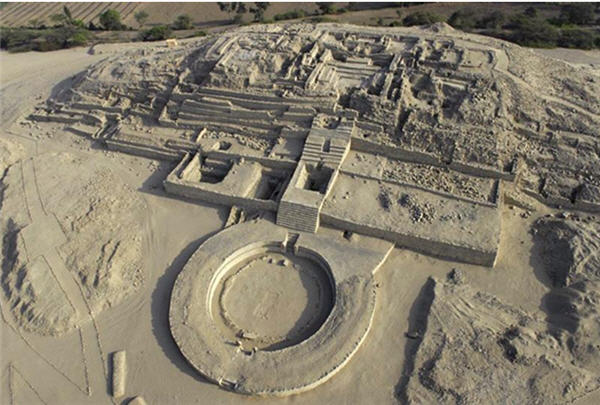As President Obama urges world leaders to tackle climate change in Paris for COP21, members from the 124 nation group of the International Union of Architects plan to present to the Paris summit the Caral Letter, a letter celebrating the ancient city of Caral-Supe in Peru as a model for sustainable living in the twenty-first century. This initiative is an example of how archaeology can be used to engage the problems our society currently faces by studying the past for ways to plan for a better future.

The city of Caral overlooking the Supe river valley.
The city of Caral-Supe was home to the Notre Chico people and can be traced back to the Late Archaic period of the Central Andes and is also the oldest center of civilization in the Americas. Caral is 5000 years old and 626 hectares, situated on a dry desert terrace overlooking the green valley of the Supe river.
Caral is famous for the ways its engineers developed the complex city using basic tools, representing inspiration to current world leaders and engineers trying to tackle climate change. The city incorporates sunken amphitheaters, pyramids, and underground ducts that once channeled winds to keep fires burning (globalpost.com). Moreover, Caral is situated in a seismically active area, and engineers of Caral innovated the use of flexible foundations called “shicras” to stabilize structures in the city.

A picture of one of the structures in the city of Caral.
The city also epitomizes a message about how our society should respect the environment. “This society was very interested in developing in harmony with nature. They never occupied the valley, they didn’t settle on productive land. Fertile fields were deities,” said Peruvian archaeologist Ruth Shady, who conducted the first excavations at Caral in 1996 and brought the site to world attention (globalpost.com). The city of Caral-Supe is an admirable example for architects to present to the climate summit not only because it serves to inspire current world leaders and engineers with the extraordinary tasks people accomplished with only basic tools, but also because the people of Caral intimately respected their environment – a pertinent message for world leaders looking to solve climate change.
The city of Caral-Supe shows that archaeology can be a means of tackling the problems our society faces today by providing examples about how we faced – and overcame – similar challenges posed in the past.
“We turn to the past to see how civilization was organized 5,000 years ago, thinking about their commitment to nature, their cosmic vision,” said Jose Arispe, one of Peru’s leading architects and an adviser with the International Union of Architects. (globalpost.com)
References
http://whc.unesco.org/en/list/1269
http://www.peruthisweek.com/news-ancient-citadel-of-caral-inspires-modern-builders-108134
Photo 1 http://media.npr.org/assets/img/2013/02/26/caral_2-6202c5022d4f3a304ac051b478a0acb728860ab7-s900-c85.jpeg
Photo 2 http://www.ancient-wisdom.com/Images/countries/American%20pics/caralpyramidmayor.jpg
Further Reading
Gigapan of Caral-Supe http://gigapan.com/gigapans/163382

Looking at past civilizations and the ways in which they adapted to their environment to live is extremely helpful in understanding the problems modern society face such as climate change. That’s one of the great uses of archaeology, discovering city remains and infrastructure can give insight into how to adapt to a shifting environment. With advanced technology and knowledge of the past, engineers can invent more sustainable ways of living that benefit the Earth and humankind. It’s important to consider that ancient civilizations created complex sites all the time without the technology we have access to today. Which speaks to the brilliance of the Notre Pico people and their knowledge of how architecture and cultural practices affect the environment.
It is fascinating to look at how cultures with very little technology have interacted with their environments. Now that COP21 is finished, I’m curious as to how the report was taken, and how it has influenced policy or proposed policy. The startegy of building earthquake safe foundations by allowing them to move with the land is certainly something that builders could incorporate into current architecture. That is one way that learning from past cultures can allow us to work with the land we live in rather than try to control it.
Past civilizations stand as guides of sustainability of our modern civilizations. We must be willing to understand that adaption and flexibility are key in supporting our growing population and needs. The city of Caral-Supe allows archeologist to develop new ideas about sustainability and the possible changes that will need to occur in order to support thriving cities today. Our leaders should be taking a stand in the struggles to preserve the environment and resources around us without having to completely shift modern society lifestyles. However, ultimately as a whole, all citizens should be taking the necessary measures to allow for a future where our children will not have to face a collapse that we set into place by not becoming more sustainable.